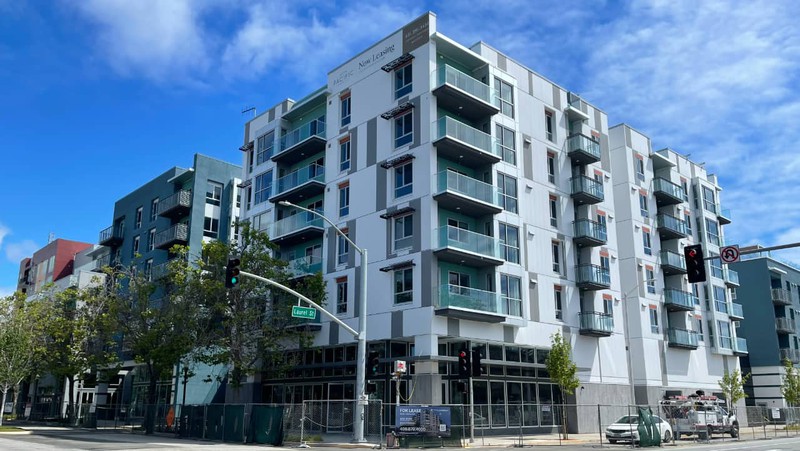Like the 33 million acres of forest in California, the nearly 15 million units of housing in the state are tended and managed with future generations in mind.

207 units of market rate housing in Santa Cruz almost ready for occupancy in May 2024 Chris Neklason contributed
Only recently has it been universally accepted that California’s decades-long housing crisis is mostly a numbers game. According to the 2022 updated US census, the latest available, there are 14,627,460 housing units in the state of California. Estimates indicate there is a need to build an additional 2.5 million units to adequately house the state’s population.
One agency is at the heart of the state’s efforts to solve this problem. In 1965, recognizing that the millions of homes in the state represented a resource on par with, say, its 33 million acres of forested lands, the California Department of Housing and Community Development (HCD) was formed. The agency was permanently established in 1975 by the Zenovich–Moscone–Chacon Housing and Home Finance Act under the California Business, Consumer Services and Housing Agency (BCSH).
The HCD’s mission includes development of a uniform building code and the regulation of manufactured homes and mobile home parks. It also regulates housing finance and economic development, and administers community development programs.
The 2023 budget for BCSH, the parent of HCD, was $5.78 billion, and the HCD 2021-2022 annual report showed $4.7 billion in grants awarded to 846 program recipients for the year. In addition to direct budget funding, HCD administers funds generated by bonds and other sources.
The building code, policy and planning arms of HCD represent a small part of the annual department outlays, with the bulk of the money being distributed to communities throughout the state via grants and funding programs.
Because housing is critical to the well-being of California residents, HCD plays an important role in the civic fabric of local communities through regulation, policy and planning, and program funding.
Regulation
California’s 58 counties are spread across a varied landscape with varying climates, and therefore different risks associated with fire, flooding and earthquakes.
The development and enforcement of a uniform building code is one way HCD works to ensure housing is built to safety and quality standards appropriate to the area.
The regulation of housing units subsidized through HCD funding ensures safe, clean and affordable housing for program recipients.
Policy and Planning
As the department charged with making sure all Californians have a safe and affordable place to live, HCD is deeply involved in the gathering and reporting of housing-related data, and the crafting of policies and plans to encourage the preservation and rehabilitation of existing housing. It is also engaged in the development of new housing in the state’s 58 counties and 482 municipalities.
Every county and municipality is required by state law to develop and update a General Plan for development, preservation and conservation within their jurisdiction. Among the mandatory elements in the plan is a “housing element” that details policies and plans to provide adequate housing for residents.
State law requires general plan housing elements to be updated by the municipality and certified as compliant by HCD every eight years.
A raft of housing laws passed in the 2023 legislative session created incentives and mandates to speed the development and construction of new housing units. HCD is charged with making sure general plan housing elements incorporate these changes, and that local oversight of the development of new housing be in compliance with state mandates.
(The 2021-2022 HCD annual report notes an oversight action taken on the City of Santa Cruz, where I live, in a case in which the City Council initially denied a 140-unit project, and then approved it following action by HCD.)
A new interpretation of an existing housing law allows developers to skirt local zoning restrictions for housing projects in which 20 percent of units are reserved for low-income residents. Known as the “builder’s remedy,” this is available only in municipalities in which the housing element is uncertified by HCD. This provides strong incentives for communities to develop general plan housing elements in compliance with state law, lest they lose control over the kinds of housing allowed to be built locally.
Funding
HCD allocates billions of dollars per year to programs under its administration, the majority of which is spent on keeping people housed through rental assistance, rebuilding housing after disasters, helping first-time home buyers, and the construction of affordable housing.
HCD has placed an emphasis on the rehabilitation and construction of affordable multifamily housing, and has streamlined the various requirements and funding sources under an umbrella of four programs:
Meeting State Housing Objectives
Again: California is working to develop 2.5 million new housing units by 2030.
The incremental housing legislation of the last several years, increased state and federal funding, and the efforts of HCD, in concert with the municipalities in the state, are now well on the path toward making the state housing objectives a reality.
Long form articles which explain how something works, or provide context or background information about a current issue or topic.